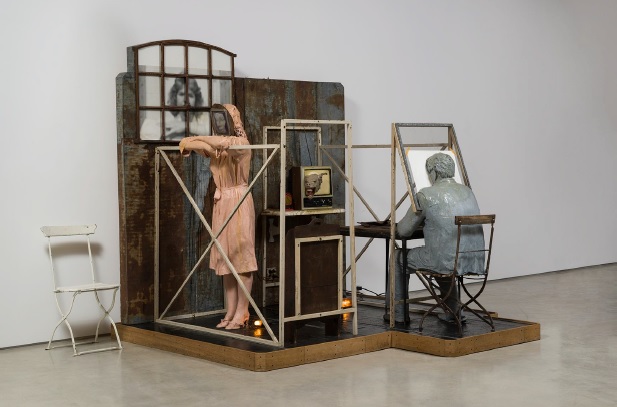Edward Kienholz Art, Bio, Ideas | TheArtStory

Edward Kienholz & Nancy Reddin Kienholz
American, 1927-1994
Bout Round Eleven, 1982
mixed media assemblage
90 x 97 x 92 in.
SBMA, Gift from Private Collection, Topanga, CA
2020.27

Nancy Reddin Kienholz - Ed Kienholz, Face to Face, 2007
“A brush is not a tool that I am naturally attuned with. But I understand an electric drill very well.” - Edward Kienholz

Nancy Reddin Kienholz - herself, Face to Face, 2007
COMMENTS
Los Angeles’ current position as an art world destination owes plenty to the pioneering efforts of Edward Kienholz. In 1957, he and others founded Ferus Gallery, which, during its brief existence, served as the city’s center for art. As an artist, Kienholz fused the new medium of “assemblage” with the iconography of his California landscape. In 1972, he began working with his wife, Nancy, a collaboration that lasted until his death in 1994. At L.A. Louver in Los Angeles, “Kienholz Televisions” offers a dozen sculptures from the artist pair, focusing on their love/hate relationship with television.
Edward Kienholz, an avid TV watcher, said he would “sit dummy style in front of that marvelous communication tool and find my years slipping by and my mind turning to slush.” Befitting this attitude, the sculptures on view at L.A. Louver reflect a deep ambivalence that will loudly resonate with fellow TV lovers. While the works critique the role television plays in American culture, they also acknowledge the hypnotic pull the small screens have on us.
Despite his love of watching, Kienholz didn’t revere the television set. The TVs in the duo’s sculptures are often battered, charred, or smashed in, sometimes looking like the remnants of a crime scene. The sculptures are often outwardly critical as well. Bout Round Eleven (1982), for instance, shows a dejected wife ignored by her husband, who can’t seem to tear his eyes from his set.
Rounding out the show is Home Sweet Home (2006), a sculpture made solely by Nancy Kienholz. The melted television, its screen broken and replaced by a glowing fire, would seem to suggest a way out, a glimmer of hope for those of us fed up with unending streams of television.
- A. Wagner, "Loving and Hating TV with Edward and Nancy Kienholz", Artsy, Mar 17, 2016
https://www.artsy.net/article/artsy-loving-and-hating-tv-with-edward-and-nancy-kienholz
“Kienholz Televisions” was on view at L.A. Louver, Los Angeles, Feb. 24–Apr. 2, 2016.
SBMA CURATORIAL LABELS
This sculpture implies the architecture of a home, with windows, walls, and rooms partially indicated. The woman, dressed in pink, looks to the world outside, while the man is lost in the violent fantasies of television—a vicious dog jumps from the screen. They are physically close but emotionally distant. This relationship is past the point of fighting, at round eleven after ten rounds in the ring. The parts of the story are all there—the separate lives, the resignation to the situation—but there remains plenty about her thoughts, and the lonely white chair to the side echoes their lack of connection. The frayed relationship in Bout Round Eleven is sadly familiar, even if we do not know all the parts of the story.
- Scenes from a Marriage: Ed and Nancy Kienholz, 2023
